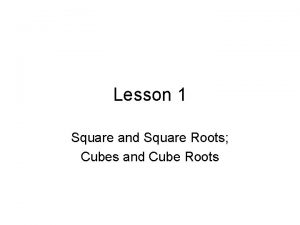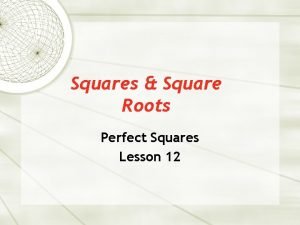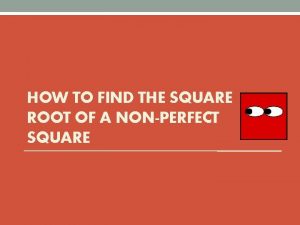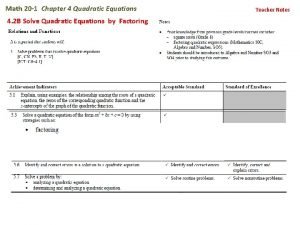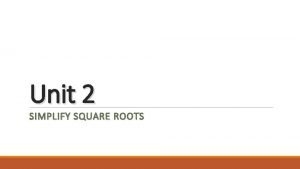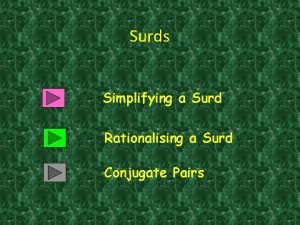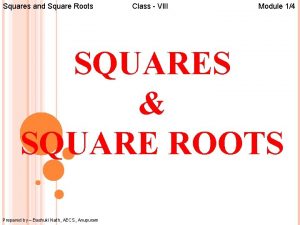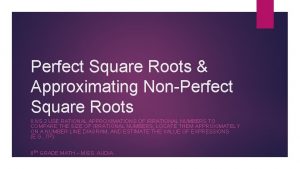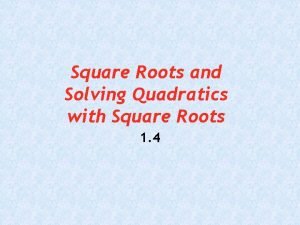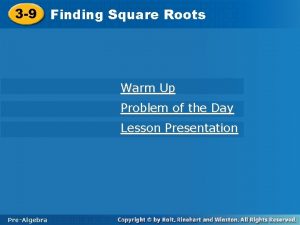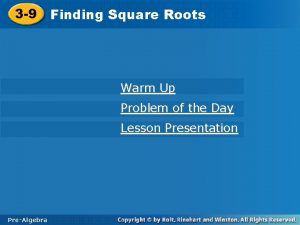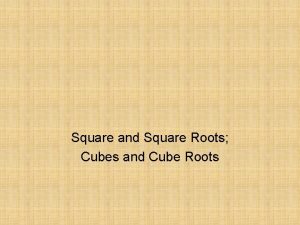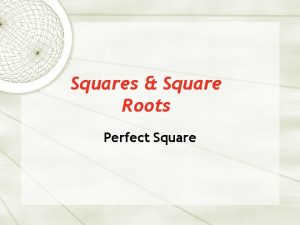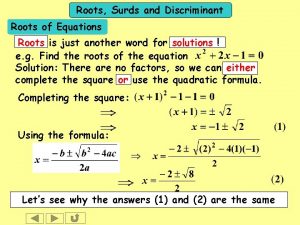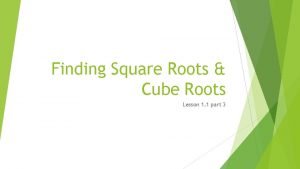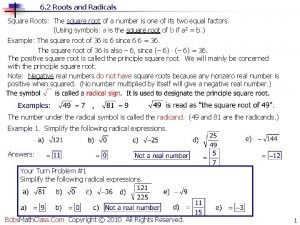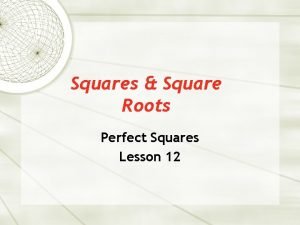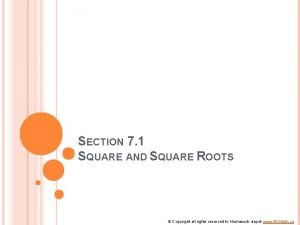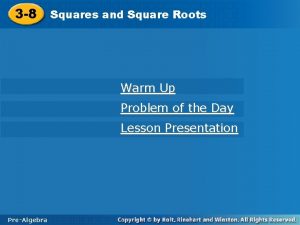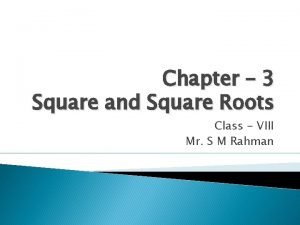Exploring Square Roots Think It Out Every square























- Slides: 23

Exploring Square Roots

Think It Out Every square is a rectangle. True Every rectangle is a square. False What are some properties we know about rectangles? • • Opposite sides are parallel and congruent (equal) 4 right angles • • • The diagonals bisect each other The diagonals are congruent The diagonals bisect has opposite angles are equal

Think It Out What are some properties we know about squares? All four sides are congruent 4 right angles • The diagonals bisect each other at right angles • The diagonals are congruent • Opposite sides are parallel >> > > • • >>

Investigate…. . • Using a piece of grid paper, make as many different rectangles as you can with each area: 4 square units 6 square units 8 square units 9 square units 10 square units 12 square units 16 square units For how many areas above were you able to make a square? 4, 9, and 16 square units How is the side length of these squares related to its area? 4 square units: side length = 2 units 9 square units: side length = 3 units 16 square units: side length = 4 units The side length of a square multiplied by itself equals the area.

Area of rectangle or square = length • width Area 3 =l·w =3· 3 = 32 =9 3 A number that is a square of an integer is called Perfect Square Or Square Number

Perfect Square List the perfect squares for the numbers 1 -12 1 2 3 4 5 6 7 8 9 10 11 12 1 4 9 16 25 36 49 64 81 100 121 144

Common Misconceptions • 52 does not equal 5 x 2 = 10 – It is 5 x 5 = 25 • Likewise, if you see 53, it is not 5 x 3 = 15 – it is 5 x 5 = 125 So what does 106 look like? 10 x 10 x 10 = 1, 000

Classwork • Page 8 #4, 5, 11, 12, 16

Recall: a square # is a number that can be written as the product of a number and itself. Ex. 9 is a square number (perfect square), since 9 = 3 x 3 = 32

Square Root Is the inverse of the square number (x 2 = x • x) What is the square root of 16? 4 x 4 Radical Sign

Investigate…. complete the factors for the chart 1 2 3 4 5 6 7 8 9 10 11 12 13 14 15 16 17 18 19 20 21 22 23 24 25 26 1 1 1 1 1 1 1 2 3 2 5 2 7 2 3 2 11 2 13 2 17 2 19 2 3 2 23 2 5 2 3 4 9 5 3 7 5 4 3 4 7 11 3 25 13 6 8 10 4 14 15 8 6 5 21 22 4 16 9 10 6 18 20 8 4 6 12 12 24 Which numbers have only two factors? What is special about these numbers? - 2, 3, 5, 7, 11, 13, 17, 19, 23 - Prime Numbers, have 2 factors Note: 1 is not a prime # as only has 1 number Which #s have an odd number of factors? What is special about these numbers? - 1, 4, 9, 16, 25 - Square numbers What seems to be true about the factors of a square number (perfect square)? - When a # has odd number of factors, it is a square number (perfect square) 26

Determining the SQUARE ROOT 36 ÷ 6 = 6 dividend divisor quotient Example 1: Find the factors of 16. 16 ÷ 1 = 16 16 ÷ 2 = 8 16 ÷ 4 = 4 16 ÷ 8 = 2 16 ÷ 16 = 1 The factors of 16 are: 1, 2, 4, 8, 16. When placed in ascending order, the middle number 4, is the square root of 16, (√ 16 = 4). When a number has an odd number of factors, it is a square number. When a number has an even number of factors, it is not a square number.

Ex. 2 Is a square number? The factors of 136: 1, 2, 4, 8, 17, 34, 68, 136. Even 136 has _______ factors, so it is an ______ number. Odd A square number has _____ number of factors; Not therefore, 136 is _____ a square #.

11 121 11

Classwork • Page 15 -16 #6, 7, 10, 13 -15, 17, 19

Math fact: The sum of any number of consecutive odd whole numbers, beginning with 1, is a perfect square e. g. 1+3=4, 1+3+5=9, 1+3+5+7=16

Square Root Recap…. • The square root ( √ ) of a number is the number that when multiplied by itself results in the given number. Example 1: Find √ 144 = 12 since 12 × 12 = 144. • We have also expressed the square root of a number as the side length of a square with area equal to the given number. Example 2: Using a diagram, show that √ 25 is 5. • The side length of a square with area 25 units 2 5 5

Investigate: Work with a partner. Use the number line below to place each square root on the number line to show its approximate value: •

Square root of a non-perfect square To estimate a square root: 1. Find the two consecutive perfect squares that the given number is between. 2. Find the square roots of these two perfect squares. 3. The square root of the given number will lie between these results. 4. The decimal place is then estimated by how close it is to either number.

Example 1: What is the √ 96? Between which two consecutive perfect numbers is 96? ~9. 8

Ex 2 What is the square root 57? Between which two consecutive perfect numbers is 57? 49 64 57 is between the perfect squares _____ and _______. 49 is ______ 7 64 is _______ 8 Square root of ____ and _____ 7&8 So, √ 57 is between ________. little over halfway 57 is a ________ from 49 to 64, 7. 5 -7. 6 so ~ ______. 49 < 57 < 64 √ 49 < √ 57 < √ 64 7 < √ 57 < 8

Example 5: Estimate √ 20 to one decimal place. 16 < 20 < 25 √ 16 < √ 20 < √ 25 4 < √ 20 < 5 A good estimate of √ 20 is 4. 4.

Classwork • p. 25 -26 #1 -5, 7, 10, 11, 13, 16, 21, 22 (calculator can be used for #13 and 16 – symbol is beside the question).
 Think big think fast think ahead
Think big think fast think ahead Perfect squares
Perfect squares Lesson 3 existence and uniqueness
Lesson 3 existence and uniqueness Opposite of squaring
Opposite of squaring 12 square numbers
12 square numbers Square and square roots
Square and square roots One direction one thing
One direction one thing Vanessa jason biology roots
Vanessa jason biology roots The roots of american imperialism 1. economic roots
The roots of american imperialism 1. economic roots Quadratic equation with roots
Quadratic equation with roots Every nation and every country has
Every nation and every country has Microsoft mission statement
Microsoft mission statement Every knee shall bow every tongue confess
Every knee shall bow every tongue confess Every rotarian every year
Every rotarian every year Every nation and every country
Every nation and every country Every picture has a story and every story has a moment
Every picture has a story and every story has a moment Every child every day
Every child every day Robin and jay poem
Robin and jay poem Think family ni
Think family ni Un-10un-1+9un-2=0 find out the root mcq
Un-10un-1+9un-2=0 find out the root mcq Blessed be your name in the land that is plentiful
Blessed be your name in the land that is plentiful Simplify square root of 8
Simplify square root of 8 What is conjugate surds
What is conjugate surds Square numbers
Square numbers



